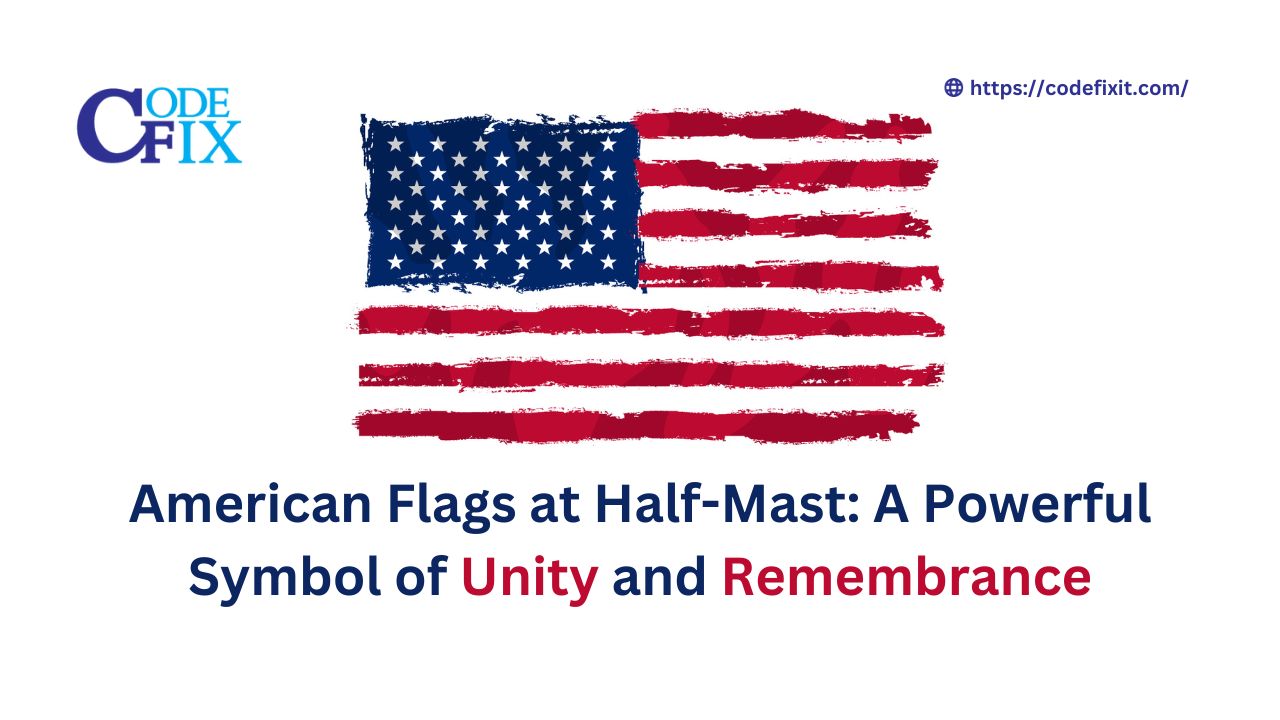In recent times, the search term “American flags at half-mast” has seen an unprecedented surge, spiking by a remarkable 1,250% in just one day. This heightened interest in the practice of lowering the American flag has left many curious about its significance and the reasons behind it. Particularly, the state of Arizona seems to be leading the way in these searches. As we delve deeper into the topic, we’ll explore the rich history and the profound symbolism behind the act of flying the American flag at half-mast. This practice goes beyond mere tradition; it is a powerful symbol of unity, respect, and remembrance that has played a crucial role in American history.
The Historical Origins of Flying the Flag at Half-Mast :
Flying the flag at half-mast is a longstanding tradition with historical origins dating back to naval customs. The practice of lowering a flag to half-mast, or half-staff, is a symbol of mourning and respect.
The tradition of flying the American flag at half-mast, also known as half-staff, has deep historical roots dating back to the 17th century. The practice began as a maritime tradition in England when ships lowered their flags to allow for the firing of salutes or to show respect to a passing vessel.
Over time, this custom extended to land-based flags and became a way to express collective mourning for significant national or international tragedies. In the United States, the practice of flying the American flag at half-mast has been formally codified through presidential proclamations. The president issues these proclamations to signify the nation’s grief and respect in response to events such as the death of a president, a national tragedy, or the passing of a prominent figure.
In the United States, the practice of flying the flag at half-mast was first officially documented in 1799. President George Washington ordered the flag to be lowered after the death of George Washington, a beloved figure who played a pivotal role in the nation’s founding. This marked the beginning of a solemn tradition that would come to symbolize the nation’s collective mourning and unity in times of loss.
Symbols of National Mourning :
When the American flag is flown at half-mast, it symbolizes a nation in mourning. When the flag is lowered, it sends a message that the nation is in a state of collective grief. This gesture is typically observed following the death of a notable figure, such as a president, a member of the armed forces, or a prominent public servant.
When the nation loses a president, the flag is lowered for 30 days as a mark of respect and mourning. Similarly, when a current or former vice president, chief justice, or speaker of the House passes away, the flag is also lowered for a specific duration. In the case of military personnel, the flag is lowered on the day of their death and continues to be lowered until they are interred. This practice not only honors their service but also underscores the solemn commitment of the nation to remember and pay homage to its fallen heroes.
The United States Flag Code provides specific guidelines on when and how to fly the flag at half-mast. For instance, the flag is usually raised to the top of the flagpole, then lowered to halfway between the top and the bottom of the staff. The duration for which the flag remains at half-mast is also specified in the presidential proclamation.
Flag Protocol :
The protocol for lowering the American flag to half-mast is well-established and is guided by official government proclamations. The process usually involves raising the flag to the top of the staff and then slowly lowering it to a position where it is one-half the distance between the top and bottom of the staff. This precise positioning is significant; it symbolizes a nation in mourning while still showing the flag’s resilience and commitment to continue flying high.
The decision to lower the flag is typically made by the President of the United States, state governors, or other appropriate authorities. When a national figure of significance passes away, the President issues a proclamation, directing the nation to lower the flag. Similarly, governors may issue proclamations at the state level to honor prominent state figures.
Notable Moments in Flag Lowering :
Throughout American history, the flag has been lowered to half-mast on numerous occasions to commemorate significant events and individuals. Among the most remarkable moments are:
The assassination of President Abraham Lincoln in 1865, which marked the first time the flag was lowered to honor a president’s death.
The September 11, 2001, terrorist attacks, during which the flag was lowered for 30 days to remember the victims
The passing of Senator John McCain in 2018, when the flag was lowered across the nation as a tribute to his service and sacrifice.
The death of prominent civil rights leader John Lewis in 2020, who was honored with the flag at half-mast.
Arizona’s Connection to Flag Lowering :
It’s no surprise that the state of Arizona has shown a strong interest in the topic of American flags at half-mast. This interest may be attributed to a variety of factors, including the state’s rich history and the significance of the flag in the southwestern United States.
Arizona, known for its stunning landscapes, has a deep connection to the principles and values represented by the American flag. The state’s unique cultural and historical background, along with its diverse population, makes it a place where the importance of national symbols is often deeply felt. Furthermore, Arizona has experienced its share of historical moments that have warranted flag-lowering ceremonies, such as the passing of notable Arizonans and other significant events that have shaped the state.
The Emotional Impact of the Flag at Half-Mast :
The act of flying the American flag at half-mast is not just a matter of protocol or tradition; it carries a profound emotional impact. When we see the flag lowered, it resonates with us on a deep level, evoking a sense of shared loss, reflection, and solidarity. It serves as a reminder that we are all part of a larger community and that our collective history is marked by both triumph and tragedy.
The emotional impact of the flag at half-mast extends to those who have a personal connection to the individual or event being commemorated. It offers a sense of closure, allowing people to express their grief and pay their respects. It can be a unifying symbol, reminding us that we are all in this together, bound by our common history and shared experiences.
In conclusion,
American flags at half-mast hold a special place in the hearts of Americans, symbolizing a shared sense of mourning, unity, and remembrance. The surge in interest in this practice, particularly in Arizona, reflects the enduring importance of these symbols in our national and regional identity. As we continue to navigate the complexities of our contemporary world, these timeless traditions remind us of the principles and values that bind us as a nation. The flag, whether flying high or at half-mast, remains a powerful symbol of resilience, sacrifice, and the enduring spirit of the United States.






